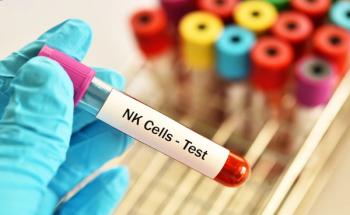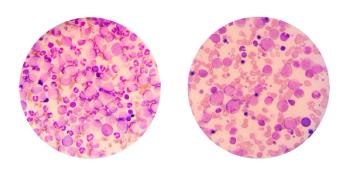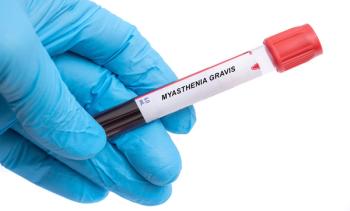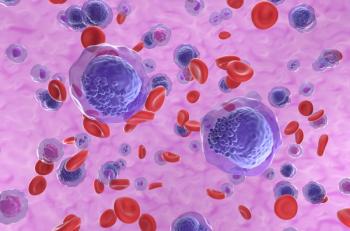
The venetoclax-based regimen was associated with an approximate $8000 decrease in costs compared with the continuous Bruton tyrosine kinase inhibitor treatment 6 months after the fixed-duration period.

The venetoclax-based regimen was associated with an approximate $8000 decrease in costs compared with the continuous Bruton tyrosine kinase inhibitor treatment 6 months after the fixed-duration period.

These findings suggest that KIR2DS2-positive (KIR2DS2+) natural killer (NK) cells could be an attractive therapeutic target for in vivo strategies, although enhanced effector function is lost during ex vivo expansion needed for NK cell–based therapies, such as chimeric antigen receptor–NK cell treatment.

When patients were re-classified based on the adjusted thresholds of N-terminal pro-brain natriuretic peptide and 6-minute walk distance and the inclusion of TAPSE rather than right atria area, classification of patients improved significantly.

The study findings underscore the importance of early initiation of macitentan and tadalafil among patients who have pulmonary arterial hypertension (PAH), and represent a shift in understanding of prognosis based on diagnosis timing.

The comparative effectiveness study found that the addition of selexipag (Uptravi) to double oral therapy (DOT) reduced the risk of patients being hospitalized or having their disease progress.

The case study, which showed prolonged disease control achieved with gilteritinib in a previously-treated patient with AML with an inv(2)(p23q13) translocation, indicates that gilteritinib can also be used as an anaplastic lymphoma kinase (ALK) inhibitor.

The study found that the price tag for the second-generation Bruton tyrosine kinase inhibitor would need to be reduced by 30% in order to be cost-effective compared with bendamustine-rituximab (R-bendamustine) for these patients.

The study showed that having pre-existing leukopenia and more favorable performance status was associated with a higher risk of rash.

Thoracoscopic thymectomy yielded quicker recovery time in myasthenia gravis (MG) while reducing disease severity, the need for treatment, and complications.

In recent years, it’s been estimated that 10% to 28% of patients with myeloid disorders develop adult onset inflammatory and autoimmune disorders (IADs), complicating treatment.

The researchers have detailed their complete findings of subcutaneous (SC) vs intravenous (IV) efgartigimod in generalized myasthenia gravis (gMG) from the phase 3 ADAPT-SC trial and initial findings from the open-label extension of the study, ADAPT-SC+.

In addition to being diagnosed more frequently in older patients, pulmonary arterial hypertension (PAH) is more frequently diagnosed in patients with cardio-pulmonary comorbidities, which poses challenges to the optimal treatment of PAH, explained the researchers.

The researchers suggest certain refinements to the 2022 European LeukemiaNet classification model for patients aged 60 years or older receiving lower intensity treatment (LIT), including the adoption of a mutation score that accounts for certain gene mutations.

The potential value of these biomarkers may help differentiate acetylcholine receptor antibody seropositive (AChR+) myasthenia gravis (MG) from healthy patients.

The European approval comes months after the FDA’s approval of the first-of-its-kind treatment for pulmonary arterial hypertension (PAH).

If integrated into clinical practice, the approach could fill a need for more optimal diagnostic approaches for myasthenia gravis (MG), explained the researchers.

By analyzing the surface proteome of a wide-ranging sample of acute myeloid leukemia (AML) specimens, researchers identified potential antigens and primitive cell markers representative of AML supgroups.

The researchers found inferior outcomes and higher accrued costs associated with alloimmunization in patients with myelodysplastic syndromes (MDS), a disease that relies on transfusion of red blood cells.

Recent years have brought a more targeted approach to treating acute myeloid leukemia (AML) based on accumulating knowledge about the genetic makeup of the heterogenous disease.

A Canadian study showed a high probability that using next-generation sequencing (NGS) for treatment sequencing based on risk stratification is cost-effective.

As the treatment landscape for chronic lymphocytic leukemia (CLL) has moved into an era where targeted treatments are a mainstay of treatment, new opportunities to tailor therapy have emerged.

The findings support previous research suggesting that worse prognosis in patients with del(6q) is not solely a result of genomic instability or presence of multiple genetic alterations.

New data from the single-center, open-label extension EDITA-ON study suggest that early treatment for pulmonary arterial hypertension (PAH) could benefit patients with systemic sclerosis and early pulmonary vascular disease.

A recent study showed that the Myasthenia Gravis (MG) Symptoms PRO scales viably measure core symptoms of the disease.

Beremagene geperpavec-svdt (B-VEC) entered the market in 2023 as the first approved corrective treatment for dystrophic epidermolysis bullosa (DEB), a rare genetic disease affecting the skin and nails that is caused by mutations in the COL7A1 gene.

The biomarker, G-protein-coupled receptor 176 (GPR176), may be a driver in the progression of ovarian cancer and potential target for gene therapy, suggested researchers of a new study.

Researchers collected feedback from 20 clinicians implementing a telehealth serious illness conversation (SIC) with their patients with acute myeloid leukemia (AML) and myelodysplastic syndrome (MDS).

The researchers noted that most genomic analyses have traditionally focused on commonly mutated genes, which can pinpoint mutations occurring most frequently but does not account for the extent to which these mutations impact cancer cell survival and proliferation.

In a recently published systematic review, researchers determined that VEXAS (vacuoles, E1 enzyme, X-linked, autoinflammatory, somatic) syndrome typically presents in men, with atypical morphology and with systemic symptoms.

In addition to ensuring residency programs provide educational and practical opportunities for addressing skin of color (SOC) hair-related concerns, prioritizing having residents of diverse backgrounds can help close knowledge and comfort gaps, suggest researchers.

259 Prospect Plains Rd, Bldg H
Cranbury, NJ 08512
© 2025 MJH Life Sciences®
All rights reserved.
